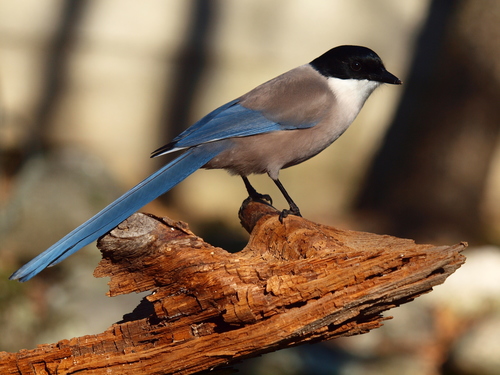
Iberian Magpie
The Iberian Magpie (*Cyanopica cooki*) is a striking member of the Corvidae family, notable for its azure-blue wings and tail contrasting with a black cap and white underparts. It is endemic to the Iberian Peninsula, occupying a unique ecological niche in the southwestern European landscape. Unlike the closely related Azure-winged Magpie found in East Asia, the Iberian Magpie is geographically isolated, leading to distinct genetic and behavioral characteristics. Its presence contributes to seed dispersal and insect control within its habitat, and it holds a place in the local culture and folklore of Spain and Portugal.
31-35 cm
Length
33-38 cm
Wingspan
Least Concern
Conservation Status
Distribution
The Iberian Magpie is restricted to the Iberian Peninsula, primarily found in Spain and Portugal. Its range encompasses a variety of habitats, showing a preference for open woodlands and cultivated areas with scattered trees.
Lifespan
Approximately 6-8 years in the wild; longer lifespans have been recorded in captivity.
Iberian Magpie's Habitat
Habitat Types
Oak woodlands, Olive groves, Cultivated farmland with trees, Cork oak forests, Riverine forests
Climate Zones
Mediterranean
Adaptations
The Iberian Magpie thrives in the Mediterranean climate, tolerating hot, dry summers and mild, wet winters. Its generalist diet allows it to exploit a variety of food sources, adapting to seasonal changes in resource availability.
Variations
No distinct subspecies are currently recognized, though some minor plumage variations might exist across its range. Genetic studies support its status as a separate species from the Azure-winged Magpie.
Appearance
Breeding Plumage
Plumage remains relatively consistent throughout the year.
Seasonal Feather Changes
Minimal seasonal variation.
Sex Based Plumage Differences
Males and females exhibit similar plumage.
Notable Features
Azure-blue wings and tail, Black cap extending to the nape, White throat and underparts, Buff-grey back
Diet and Feeding
Primary Foods
Insects, Fruits, Seeds, Nuts, Small invertebrates, Carrion (occasionally)
Foraging Behavior
Iberian Magpies are opportunistic omnivores, foraging on the ground and in trees. They often forage in small family groups, hopping and walking while searching for food. They are known to cache food items, storing them for later consumption.
Specializations
Their strong beaks allow them to manipulate a wide range of food items, from cracking nuts to probing for insects.
Seasonal Diet Variations
Diet shifts seasonally depending on availability. Insects and fruits are more prevalent in the diet during spring and summer, while seeds and nuts become more important in autumn and winter.
Behavior
Social Structure
Iberian Magpies are highly social, living in family groups that may consist of parents and offspring from multiple breeding seasons. These groups maintain territories and often cooperate in foraging and defense.
Communication
Variety of calls, including a harsh 'chack-chack' alarm call, Soft chattering sounds during social interactions, Visual displays, such as tail-flicking and wing-fluttering
Migration
The Iberian Magpie is a non-migratory species, remaining within its breeding range year-round.
Territorial or Group Behaviors
Family groups defend territories, particularly during the breeding season. They exhibit cooperative breeding behavior, with older offspring sometimes helping to raise younger siblings.
Conservation
Threats
Habitat loss due to agricultural intensification, Illegal hunting and trapping (though less common now), Use of pesticides in agriculture (indirectly through food chain)
Protection Programs
Protected under European Union Birds Directive, Habitat restoration initiatives in some areas
Local National Laws
Protected under Spanish and Portuguese national legislation.
Population Trend
Stable
Population Estimates
Estimated at several hundred thousand individuals, but precise numbers are difficult to obtain.
Interesting Facts
They were once considered the same species as the Azure-winged Magpie.
Genetic studies in the late 1990s and early 2000s confirmed their distinct species status, separated by thousands of kilometers.
They are known for their intelligence and problem-solving abilities.
Like other corvids, they exhibit complex cognitive skills, including tool use and caching behavior.
They can recognize individual human faces.
Studies have shown that corvids, including magpies, can distinguish between different people and remember those who have threatened them.
Faqs about Iberian Magpie
Are Iberian Magpies related to the magpies found in North America?
They are related, as both belong to the Corvidae family, but they are different genera and species. The North American magpies are typically of the genus *Pica*.
Do Iberian Magpies migrate?
No, Iberian Magpies are resident birds, staying within their breeding range throughout the year.
Are Iberian Magpies pests?
While they can sometimes cause minor damage to crops, their overall impact is generally considered minimal. Their role in insect control often outweighs any negative effects.
Copyright @ Nature Style Limited. All Rights Reserved.
 English
English